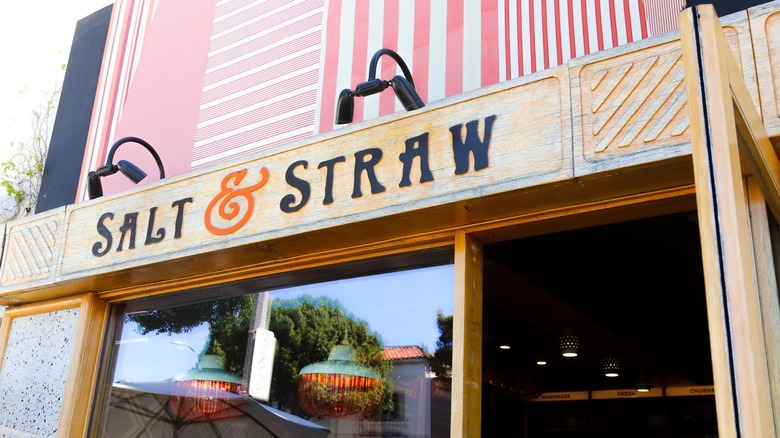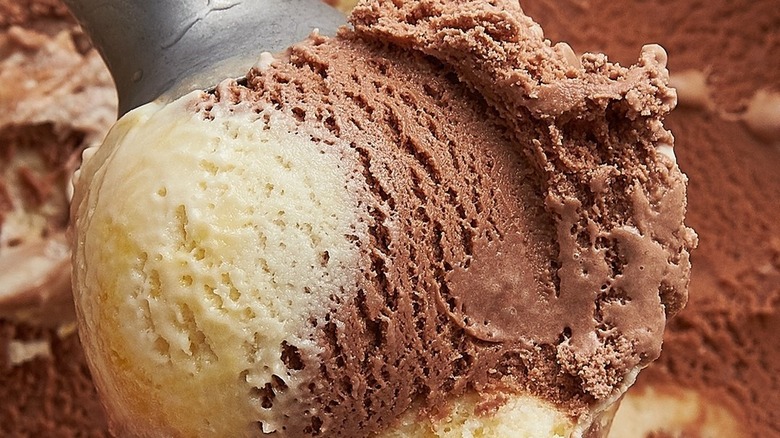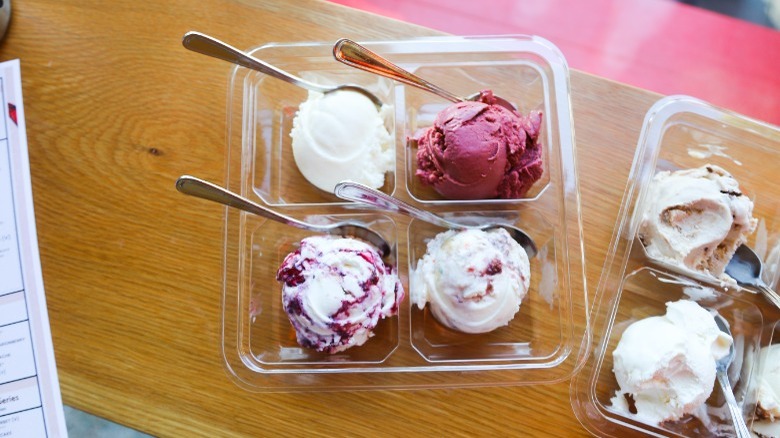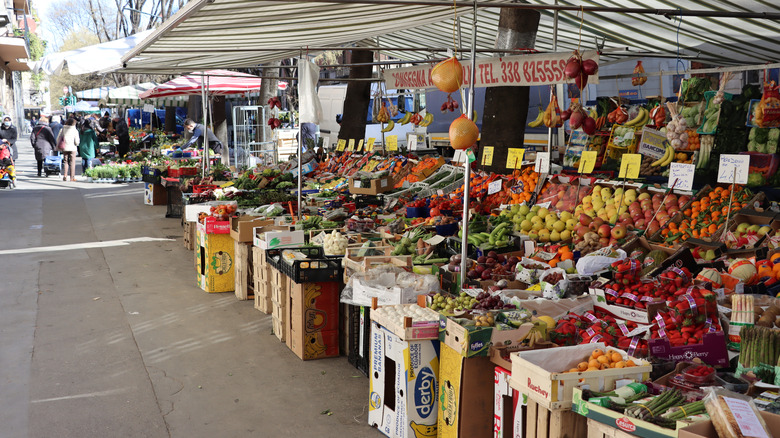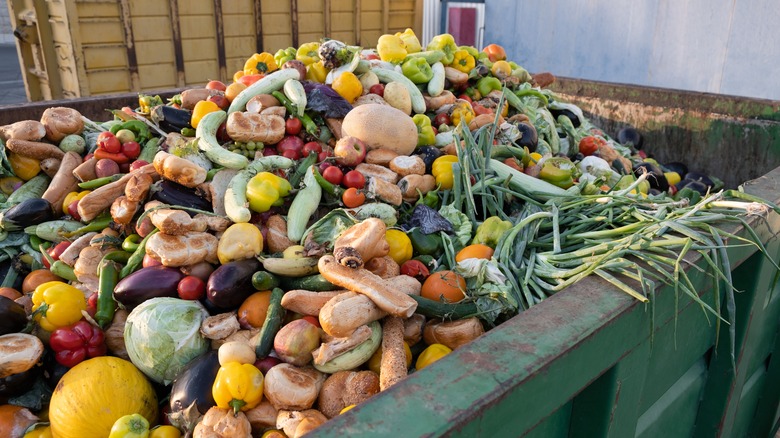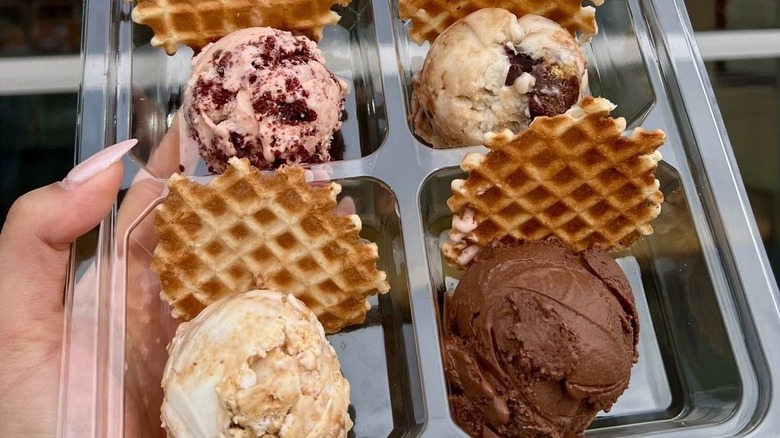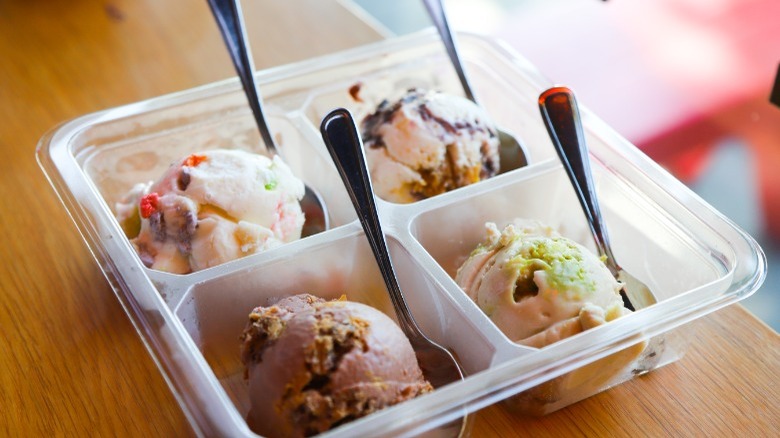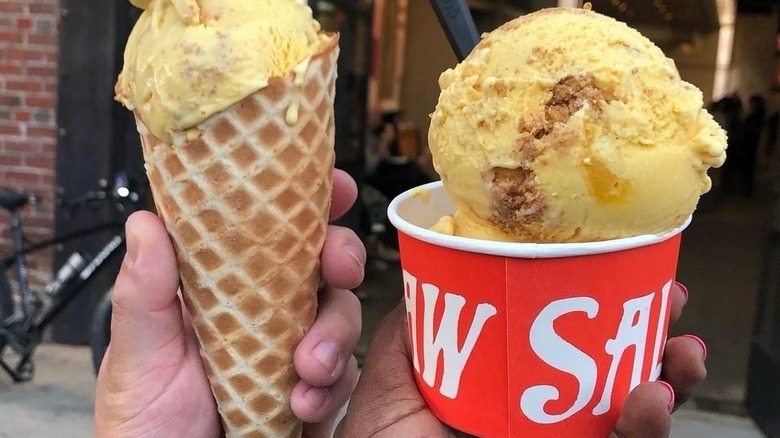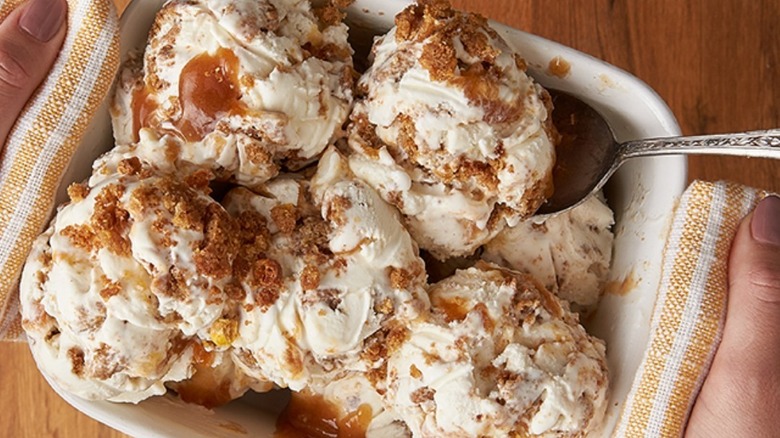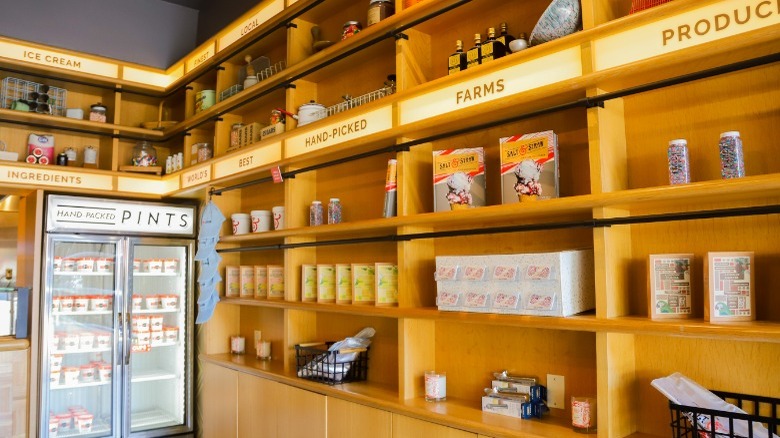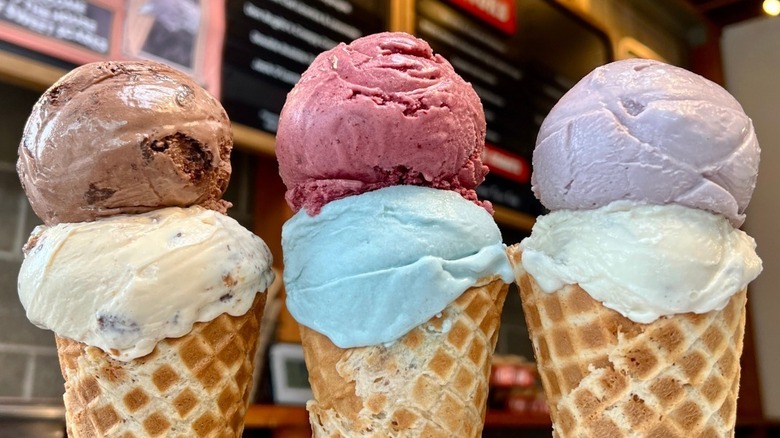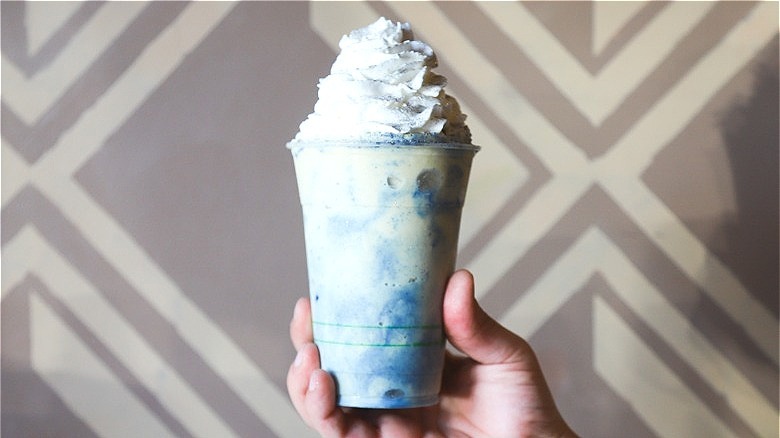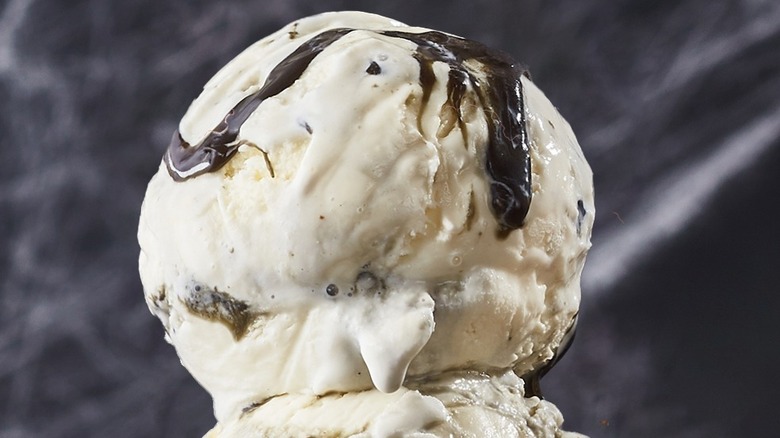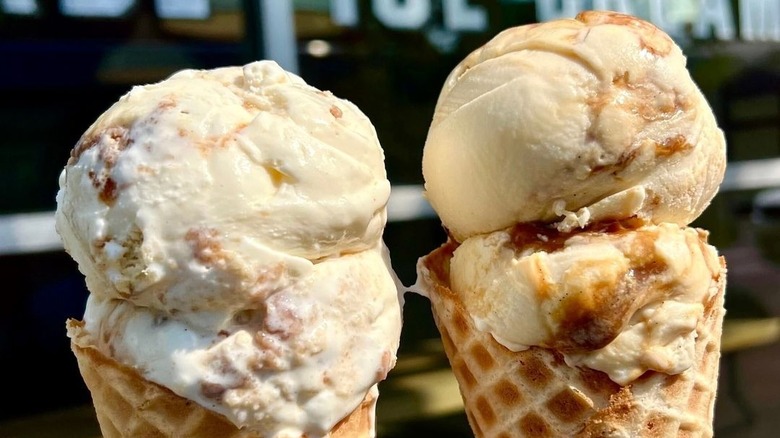The Secrets Behind Salt & Straw's Unique Ice Cream Flavors - Exclusive
I scream, you scream, we all scream for Salt & Straw, the Portland-based creamery known for inventive flavors and "farm-to-cone" ethos. Founded in 2011 by cousins Kim and Tyler Malek, the company began with a mission to work with local artisans, farmers, and craftsmen to create flavors that cooperate with the community and tell a "culinary story." This mission has helped solidify Salt & Straw's cult following, along with some decidedly crave-able flavors that are unlike anything else we've seen in the ice cream world. Flavors like Duck Crackling and Cherry Preserves or Arbequina Olive Oil put this ice cream company on the map and even caught the attention of big stars like Oprah.
We caught up with Tyler Malek to hear about Salt & Straw's upcoming flavors and the new shop opening in the Silverlake neighborhood of Los Angeles in hopes that we might learn a bit about what it takes to make the perfect scoop.
Start with a solid base
When we asked Malek his number one tip for making ice cream at home, he simply told us, "Start with a good base." Typically, most ice cream (not including sorbets, sherbet, or gelati) begins as a base. This base is very close to a creme anglaise and involves cooking a mixture of milk, cream, sugar, and eggs. Once that mixture has cooked and cooled, it goes into an ice cream machine where it is churned and chilled simultaneously. The constant motion of the ice cream machine incorporates air, which makes the ice cream fluffy and light, and ensures the sugar crystals freeze super-small, which keeps it from getting icy or crunchy.
No ice cream machine? No problem. A perfectly good homemade ice cream can be made without a machine, or you could always make super-simple two-ingredient ice cream with just a whisk. Either way, the principles of starting with a good base remain the same.
Come up with a theme
In the process of making a new flavor, Malek told us the first question is always, "What is the theme? What's the story we're trying to tell?" For his research and development team, the theme can be based on seasons, chefs, partners, or even nonprofit programs like the "Upcycled Food" flavor series. The theme is the "hardest part of every project for us," says Malek. After that, the inspiration just starts flooding in.
Once a theme is chosen, the flavor practically "makes itself," as Malek told us. If you are struggling to come up with something original in your ice cream making, take a step back and try to hone in on a theme. It could be something simple, like seasonal produce, or something personal to you, like a favorite childhood dessert. Cooking from the heart in this way will always yield something greater than something with no soul, even if the best possible ingredients and techniques are used.
Wander the farmers' market
It's no secret that great base products make great final dishes, which is why you should head straight to the source if you want to make the best possible ice cream. "97% of all our ingredients are from Oregon and California," said Malek, who believes in infusing the best of what the West Coast has to offer.
Follow Malek's advice and start by creating an extra-large batch of ice cream base, then stash some away in your freezer. Now that you have the hard part down, you can go to your local farmer's market and choose some ingredients that inspire you. "Find a pint of strawberries and some great local chocolate," says Malek, then defrost the base, blend the strawberries into it, and boom, amazing ice cream. Farmers tend to have great ideas for using their produce or products in new and different ways, so stay and chat with them for awhile for extra inspiration.
Save your waste
Some say, "when in doubt, throw it out," but with 119 billion pounds of food getting wasted each year in the U.S., per Feeding America, wouldn't it be better to let some of that waste inspire something new? Salt & Straw's June menu features "upcycled food," proving that food waste can actually be a food win. In a bid to realign the public's perception of food waste, Malek reached out to the community to find sources of perfectly good and edible food that were otherwise going into the trash.
Spare Food Co. makes a delicious tonic using the whey leftover from Brooklyn-based yogurt makers, The White Mustache, and that whey is now getting another outlet in Salt & Straw's Lemon Curd & Whey flavor. Portland-based Urban Gleaners rounded up some day-old bread for the Bread Pudding and Chocolate Ganache flavor, and Blue Stripes Cacao helped create the Cacao Pulp and Chocolate Stracciatella Gelato.
Understand the role of fat
We all know that it's possible to over-whip cream so much that it turns to butter, and this can make churning ice cream with a high-fat content difficult. Fat plays an important role in making ice cream creamy without turning icy. The folks at Salt & Straw told us they use the highest ratio of fat you can use in ice cream before it starts churning to butter in the machine, right around 17%. This results in tasty, flavorful ice cream with just the right texture.
That being said, the developers at Salt & Straw will sometimes adjust the fat so it doesn't wash out the flavor. Vanilla, for example, uses the highest level of fat, while the marionberry flavor would get washed out at 17% fat. The olive oil flavor goes above 17% fat because of the added olive oil, which can't churn to butter, giving it extra richness without affecting texture.
Try unexpected ingredients
It never hurts to think outside of the box. Some of the unusual ingredients that have popped up in Salt & Straw ice creams include blue cheese, potato salad, bone marrow, duck skin, and even sea urchins. Of all these flavors that have come and gone over the years, Malek's favorite is the Arbequina Olive Oil. The rich peppery flavor of the olive oil plays perfectly with the creamy ice cream base and creates an ultra-silky texture. Without branching outside the bounds of ingredients traditionally thought of as "dessert," this famous flavor may not have ever happened (which would've been so sad to us).
Of course, these unusual ingredients are not used just for the sake of being strange. Each has certain properties that contribute to the overall flavor and texture. Just like miso can be the umami-rich ingredient that elevates caramel sauce, olive oil can easily elevate ice cream.
Mix the sweet with the savory
There's just something about a mix of sweet and savory that hits the spot more than one or the other can do on its own. That's why salt can make fruit taste better, not to mention the fact that salt amplifies food's natural flavor. Don't believe us? Try adding a pinch to your next batch of cookies or sprinkling some brownies with flaky sea salt (it would be a mistake to make brownies without it).
Many of Salt & Straw's flavors go for a blend of sweet and savory, like the Pear and Blue Cheese flavor or Bone Marrow & Smoked Cherries. You can implement this concept in your ice cream at home by going for a simple combination of peanut butter and chocolate. If you want to get more creative, think of some pairings that work outside of the world of ice cream, like strawberries and Parmesan. Then, try to envision some ways this could work in ice cream.
Consider the texture
Anything that gets added to ice cream, be it a cookie crumble or a ribbon of caramel, will change in texture once frozen. The ice cream itself will transfer moisture and fat as well, which can lead to sogginess, crystallization, and other unpleasant textures. The science of food is an important thing to keep in mind when making ice cream as it can dramatically impact the final texture.
According to Malek, sometimes you have to denature an ingredient a bit to get it to work. For example, the ice cream developers at Salt & Straw toast brownies to a biscotti texture before folding them into the ice cream to ensure it doesn't get soggy. High-sugar ingredients like the jam in the Wild-foraged Berry Pie flavor have to be just the right thickness to still be gooey once frozen, even if that means making it a completely different way than you would ordinarily. Malek also likes to keep the seeds in the marionberry jam, because the crunchy texture adds to the experience.
Be prepared for failure
The price of experimentation can come with the risk of failure. That's what Malek told us when discussing one of his worst creations: a crab-flavored ice cream. After being approached by the Oregon Crab Commission, the research and development team had big plans for a flavor based on a crab roll. "It was one of the worst things I've tasted in my life," said Malek, who tried over 30 different versions before calling it quits. But, there is always a silver lining in every failure.
"There's like, 20 or 30 recipes that we've written since then that are roughly based off things that failed," Malek told us. You can't be afraid to try new things if you want to come up with something truly unique. Sure, some things may not always work, but those failures could lead to success, or at the very least teach you something about what does, or doesn't, work.
Taste, taste, taste away
True perfection requires a lot of trial and error, and all chefs know that the best way to cook and develop new flavors is to taste, taste, and taste some more. Malek told us that each flavor that reaches stores goes through on average 15 rounds of tasting before being approved. Malek has regular meetings with his research and development team, where he tastes what amounts to "a full pint of ice cream almost every day."
All this tasting helps drive the ever-present pursuit of perfection and is the only way to ensure that everything is staying consistent batch-to-batch, even as raw produce can change in texture and flavor by the week. Taste your base, your mix-ins, and the final product. Be sure to taste outside your own creations, as well. Tasting ice creams from other manufacturers can help get the creative juices flowing, and help you narrow down what exactly makes a certain flavor so great.
Choose ingredients from the heart
When you find yourself at a creative standstill, sometimes the best place to look for inspiration is in the things you love. A core part of Salt & Straw's philosophy is to lead with the heart and to start there whenever coming up with new flavors. Even though the team likes to use organic wherever possible, Malek decided to do the "Cereal-sly Delicious" series because he loves cereal and chose to partner with OffLimits because they are friends. The "Upcycled Food" series came about because Malek is truly passionate about "reshaping the narrative around ... food that goes uneaten or unsold in the U.S. each year."
Not only does this type of friendship help support the business of friends and colleagues in Malek's community, but these partnerships also help inspire further collaborations and flavors that hadn't previously been thought of. Salt & Straw is also now in a position to use its purchasing power to support these artisans, which we're here for, and is a good principle to apply to your own ice cream making if you can.
Temper the sweetness
Even though ice cream is a dessert, the best desserts have more dimension than just sweetness. At a certain point, straight sugar can start to be a bit boring for the taste buds. One of Salt & Straw's most popular flavors is the Salted, Malted Chocolate Chip Cookie Dough. While many other ice cream companies offer just a simple chocolate chip cookie dough ice cream, this company sets this classic flavor apart from the rest by adding Jacobsen sea salt and malt that is typically used to make amber ale.
By backing off the sweetness a touch and harmonizing other flavors like rich malt and sea salt, the end result takes on a deliciously interesting and crave-able flavor that's hard to put down. Other flavors can help temper the sweetness while also maximizing flavor, like acidity from fruit or vinegar or bitterness from coffee or dark chocolate (even though dark chocolate prices may be rising).
Layer the flavors
To squeeze the most flavor out of each and every bite, get creative with the ways you add ingredients in. For example, Malek told us that the Double-Fold Vanilla flavor gets the signature vanilla from both vanilla bean and vanilla extract to make sure the floral notes of the fruit truly shine through. Instead of just plain strawberry ice cream, local strawberries get augmented with balsamic vinegar and black pepper so that the strawberry comes through stronger without adding artificial flavor. Roasting the pineapple adds extra depth to the coconut sherbet, which would otherwise veer toward piña colada.
If you are thinking of adding an ingredient to your ice cream, brainstorm multiple ways of adding it. Some things can be steeped in the hot ice cream base as well as folded in. When you find yourself stuck, check out a book like "The Flavor Bible," which outlines various ingredients and flavors and pairs them with other complementary flavors.
